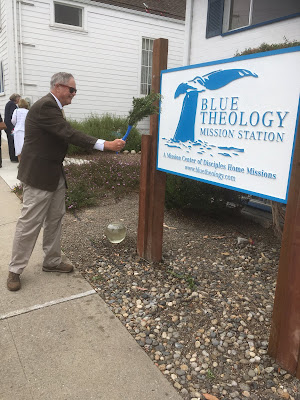Fleshy Algae
“God seems especially fond of diversity,” we often say on
our “spiritual tours” of the Monterey Bay Aquarium.
 Animals come in so many different sizes, colors, how they
find dinner, strategies for not being someone else’s dinner, techniques for
finding a mate or making babies. If there
was one best most efficient way, everyone would do it. But no, we see such diversity in all
creation.d
Animals come in so many different sizes, colors, how they
find dinner, strategies for not being someone else’s dinner, techniques for
finding a mate or making babies. If there
was one best most efficient way, everyone would do it. But no, we see such diversity in all
creation.d
We try to make this key theological point with our Blue
Theology youth service groups and adult pilgrims along the Monterey Bay.
Usually it’s the fish I point to make this diversity point,
but it works also with plants and algae.
This past week the fabulous algae/seaweed expert Dr. Judith Connor
taught us Aquarium volunteers about “fleshy algae” before we went on shift. (She gave this half hour presentation to 19
different shifts throughout the week – thanks!)
Fleshy algae! Just
the term got our attention. Turns out
in Monterey Bay there over 700 different kinds of fleshy algae (which means
they are the ones that are not calcified, like coralline algae.) They’re fleshy. 700.
Here was the best part – her descriptive adjectives. Maybe it’s just me, but these are some
fabulous adjectives.
Dr. Connor says that fleshy algae comes in five different
textures or body types. (I’ll give just one example of each type.)
-Velvety – dead man’s fingers
-Leathery – giant kelp
-Bumpy – cow’s tongue
-Corrugated – sea palm
Some obvious advantages – if you are bumpy you have more
surface area to absorb food, like our intestines. If you are velvety/slippery it’s hard for an
animal to land on you and eat you.
Diverse adaptations to find dinner and not be someone else’s dinner.
Dr. Connor, who is also a master gardener, referred to these
wet landscapes, with hundreds of Monterey Bay algae, as gardens, or meadows,
all growing and thriving diversely together.
“Consider the fleshy algae of God’s ocean meadows, how they
grow. They neither spin not toil, but
Solomon in all his glory is not arrayed as one of these.”
___________________
Come and sea our fabulous fleshy algae along the shores of
Monterey Bay, half a block from our Blue Theology Mission Station at the
Pacific Grove Christian Church, or on a
spiritual tour of the Aquarium. Blue
Theology.com for info on day trips, weekends, a week doing ocean learning and
serving. I post these ocean devotions
every Wednesday here and on Facebook. (Ask to join the FB Blue Theology Mission Station group
and you’ll get a notice of every new post.)
Fabulous photos of sea palm and dead man’s fingers by NOAA’s Steve Lonhart.




